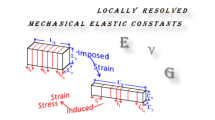Abstract
In a nanostructured material, the interface-to- volume ratio is so high that the interface energy, which is usually negligible with respect to the bulk energy in solid mechanics, can no longer be neglected. The interfaces in a number of nanomaterials can be appropriately characterized by the coherent interface model. According to the latter, the displacement vector field is continuous across an interface in a medium while the traction vector field across the same interface is discontinuous and must satisfy the Laplace–Young equation. The present work aims to elaborate an efficient numerical approach to dealing with the interface effects described by the coherent interface model and to determining the size-dependent effective elastic moduli of nanocomposites. To achieve this twofold objective, a computational technique combining the level set method and the extended finite element method is developed and implemented. The numerical results obtained by the developed computational technique in the two-dimensional (2D) context are compared and discussed with respect to the relevant exact analytical solutions used as benchmarks. The computational technique elaborated in the present work is expected to be an efficient tool for evaluating the overall size-dependent elastic behaviour of nanomaterials and nano-sized structures.
Similar content being viewed by others
References
Miller RE and Shenevoy VB (2000). Size-dependent elastic properties of nanosized structural elements. Nanotechnology 11(3): 139–147
Haile JM (1992). Molecular dynamics simulation. Wiley, New York
Hoover WG (1986). Molecular dynamics. Springer, Berlin
Rapaport DC (2004). The art of molecular dynamics simulation. Cambridge University Press, New York
Povstenko YZ (1993). Theoretical investigation of phenomena caused by heterogeneous surface tension in solids. J Mech Phys Solids 41: 1499–1514
Hadal R, Yuan Q, Jog JP and Misra RDK (2006). On stress whitening during surface deformation in clay-containing polymer nanocomposites: a microstructural approach. Mater Sci Eng A 418: 268–281
Benveniste Y (2006). A general interface model for a three-dimensional curved thin anisotropic interphase between two anisotropic media. J Mech Phys Solids 54: 708–734
Gurtin ME, Weissmuller J and Larche F (1998). A general theory of curved deformable interfaces in solids at equilibrium. Philos Mag A 78(5): 1093–1109
Sharma P and Ganti S (2006). Size-dependent Eshelby’s tensor for embedded nano-inclusions incorporating surface/interface energies. J Appl Mech Trans ASME 71(5): 663–671
Sharma P, Ganti S and Bathe N (2003). Effect of surfaces on the size-dependent elastic state of nano-inhomogeneities. Appl Phys Lett 82(4): 535–537
Chen T, Dvorak GJ and Yu CC (2007). Solids containing spherical nano-inclusions with interface stresses: Effective properties and thermal-mechanical connections. Int J Solids Struct 44((3-4)): 941–955
Duan HL, Wang J, Huang ZP and Karihaloo BL (2005). Size-dependent effective elastic constants of solids containing nano-inhomogeneities with interface stress. J Mech Phys Solids 53(7): 1574–1596
Sharma P, Ganti S (2005) Erratum: “Size-dependent Eshelby’s tensor for embedded nano-inclusions incorporating surface/interface energies” (J Appl Mech 71(5):663–671, 2004). J Appl Mech Trans ASME 72:628
Sharma P, Ganti S, Bathe N (2006) Erratum: “Effect of surfaces on the size-dependent elastic state of nano-inhomogeneities (82:535, 2003). Appl Phys Lett 89(4), No. 049901
Le Quang H, He Q-C. Estimation of the imperfect thermoelastic moduli of fibrous nanocomposites with cylindrically anisotropic phases. Arch Appl Mech (submitted)
Le Quang H and He Q-C (2007). Size-dependent effective thermoelastic properties of nanocomposites with spherically anisotropic phases. J Mech Phys Solids 55(9): 1889–1921
Dingreville R, Qu J and Cherkaoui M (2005). Surface free energy and its effect on the elastic behavior of nano-sized particles. J Mech Phys Solids 53(8): 1827–1854
Gao W, Yu S and Huang G (2006). Finite element characterization of the size-dependent mechanical behaviour in nanosystems. Nanotechnology 17: 1118–1122
Osher S and Sethian JA (1998). Fronts propagating with curvature-dependent speed: algorithms based on Hamilton–Jacobi formulations. J Comput Phys 79(1): 12–49
Belytschko T and Black T (1999). Elastic crack growth in finite elements with minimal remeshing. Int J Numer Methods Eng 45(5): 601–620
Moës N, Dolbow J and Belytschko T (1999). A finite element method for crack growth without remeshing. Int J Numer Methods Eng 46(1): 131–156
Sukumar N, Chopp DL, Moës N and Belytschko T (2001). Modeling holes and inclusions by level sets in the extended finite-element method. Comput Meth Appl Mech Eng 190: 6183–6200
Sukumar N, Huang ZY, Prevost J-H and Suo Z (2004). Partition of unity enrichment for bimaterial interface cracks. Int J Numer Methods Eng 59: 1075–1102
Do Carmo MP (1976). Differential geometry of curves and surfaces. Prentice-Hall, New Jersey
Thorpe JA (1979). Elementary topics in differential geometry. Springer, Berlin
Cammarata RC (1994). Surface and interface stress effects in thin films. Progr Surface Sci 46: 1–38
Chessa J and Belytschko T (2003). An enriched finite element method and level sets for axisymetric two-phase flow with surface tension. Int J Numer Methods Eng 58: 2041–2064
Belytchko T, Parimi C, Moës N, Sukumar N and Usui S (2003). Structured extended finite element method for solids defined by implicit surfaces. Int J Numer Methods Eng 56: 609–635
Moës N, Cloirec M, Cartraud P and Remacle J-F (2003). A computational approach to handle complex microstructure geometries. Comput Methods Appl Mech Eng 192: 3163–3177
Shenoy VB (2005). Atomistic calculations of elastic properties of metallic fcc crystal surfaces. Phys Rev B 71: 094104
Barrett R, Berry M, Chan TF, Demmel J, Donato J, Dongarra J, Eijkhout V, Pozo R, Romine C, van der Vorst H (1994) Templates for the solution of linear systems: building blocks for iterative methods. SIAM, Philadelphia
Author information
Authors and Affiliations
Corresponding author
Rights and permissions
About this article
Cite this article
Yvonnet, J., Quang, H.L. & He, Q.C. An XFEM/level set approach to modelling surface/interface effects and to computing the size-dependent effective properties of nanocomposites. Comput Mech 42, 119–131 (2008). https://doi.org/10.1007/s00466-008-0241-y
Received:
Accepted:
Published:
Issue Date:
DOI: https://doi.org/10.1007/s00466-008-0241-y




